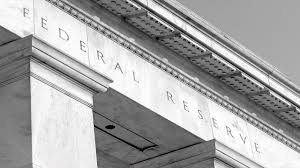After Fed’s Rate Cut, ‘They’re Out of Ammo’ to Fight Recession

There’s not much lower they can go.
When the Federal Reserve lower short-term rates on Wednesday, it further hobbled its ability to combat the next recession via radical rate chopping. So, as an antidote to bad times, the Fed’s fallback will be to resume its bond buying program. That has limitations, too.
The Fed’s main recession-fighting tool has long been lowering the benchmark federal funds rate, which governs short-term rates for things ranging from auto loans to credit card charges. In the past, the average reduction needed to fight a recession was a whopping 5.5 percentage points. Such a bold step is mathematically impossible now.
The Federal Open Market Committee, or FOMC, its policymaking arm, just decreased the rate a quarter-point to a 2.0% to 2.25% band, thus not a lot of room exists to cut much more. And if the Fed ends up decreasing the rate another half-point, as many suspect it will, then the central bank has even less to work with.
“They’re out of ammo,” said economist Gary Shilling, who owns his own eponymous firm. “Going from 2.25% to zero is not an awful lot.”
The New York Fed’s recession model, which has been prescient in the past, finds a 32.8% chance of one arriving in the next 12 months. That 32.8% is almost the same as the level as in early 2007, just before the Great Recession began that December. Meanwhile, the Duke University survey of chief financial officers in June found that 69% expect a recession by the end of 2020.
The upshot is that Fed Chairman Jerome Powell must rely more than before on buying bonds, known as quantitative easing or QE—a maneuver that gives commercial banks fresh money, so they can make loans and thus bolster the economy.
The mechanics of QE are that a central bank creates new money out of thin air and deploys it to buy assets, mostly bonds from commercial banks. With all this fresh cash, those banks can lower their interest rates and make more loans. The theory is that it’s easier then for companies and consumers to get credit, which is supposed to benefit the economic system.
Lowering interest rates
What everyone can agree on is that the interest rate tool has been mostly neutered. “The Fed has less flexibility than in the past,” said Mohamed El-Erian, the chief economic adviser at Allianz, at the Davos conference last winter.
The best they can hope for is that the next recession will be the mild one that many forecasters expect. Remember, though, that in 2007 the conventional wisdom was that the sub-prime mortgage meltdown could be “contained.”
The environment of very low rates over the past decade has sapped the Fed’s power. The FOMC’s first line of defense during the 2008-09 crisis was a drastic plunge in the fed funds rate, to near-zero from 5.25%. After economic growth appeared to be on a sustainable track, the Fed in late-2015 started to gradually lift the rate back to normal levels.
It didn’t get very far, only to a 2.25%-2.50% target range, when worries about the U.S.-China trade war, slowing European growth and other factors made Powell pause. Widespread Wall Street fretting that the Fed had raised too much and might choke off the recovery weighed on the central bank. So did the relentless pressure from President Donald Trump, who needs a decent economy when he runs for reelection next year.
Resuming bond buying
What happens if the Fed reverses course and starts purchasing bonds once more? There’s a school of thought that this too will be less effective than in the past. Reason: Banks have so much extra funding these days that they don’t know what to do with all the money. The previous rounds of QE, which finally ended in 2014, stuffed banks with trillions of new dollars, which they hold in reserve to buffer themselves against economic bad spells and also to make loans. Plus, loan demand is low, even now in an expansion. Demand will be a lot less in a recession.
“Excess reserves in the banking system are currently so extraordinarily high that it is difficult to imagine” institutions lending out much of the money, said economist Hugh Johnson, who heads Hugh Johnson Advisors.
The Fed started buying Treasury bonds and mortgage-backed securities in 2010 and stopped in 2014, when it has amassed $ 4.5 trillion. That was a massive ballooning of its balance sheet, which held just $ 870 billion in August 2007, right before the financial crisis. The Fed had been reducing its asset holdings since late 2017 and intends to stop on Thursday, Aug. 1. Now this hoard has dwindled to $ 3.8 trillion, as of July 15, which is still a giant number.
As of June, Johnson pointed out, bank excess reserves (not needed to meet regulatory and creditors’ requirements) were $ 1.27 trillion, well above the pre-crisis average of $ 1.5 billion. At the same time, loan demand remains low, he said.
If the Fed has less power to offset an economic slump, the mantle then falls to fiscal policy—slicing taxes and boosting federal outlays. With federal red ink likely to top $ 1 trillion this year, countering the next recession, it seems, will fall solidly in the political arena.
More must-read stories from Fortune:
—Mortgages, credit cards, loans—what will happen if the Fed cuts interest rates?
—Stocks have been this expensive only twice in history: 1929 and 2000
—Here’s what analysts say about the top 8 pot stocks you can buy
—Debit cards for kids? Here’s what you need to know about the newest offerings
—The expiration of this key mortgage rule could upend the housing market
Don’t miss the daily Term Sheet, Fortune‘s newsletter on deals and dealmakers.






